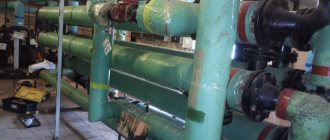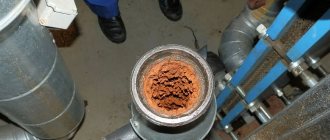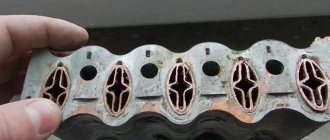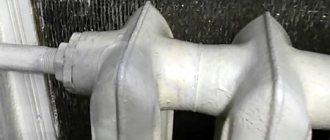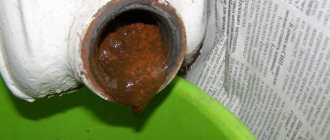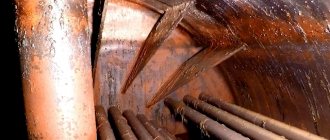Autonomous heating is installed in many apartments and most private houses that have their own water supply. This system is not designed to operate forever without maintenance and preventative measures. The water circulating through the circuit is not ideally clean. During heating in the range of 45-75 degrees, limescale forms in the pipes, and soot collects outside. This negatively affects the efficiency of the equipment and leads to many undesirable phenomena. To prevent this, the boiler heat exchanger is cleaned. It is better to carry out this procedure yourself, since the services of a specialist will cost a hefty sum. The tubes should be cleaned regularly as they become dirty.
Need for cleaning
High-quality flushing of the gas boiler heat exchanger is the key to its long and trouble-free operation throughout the heating season. Facing the need to turn off the heat and undergo emergency repairs during this period is not the best prospect that a property owner wants to face.
If you do not clean the heat exchangers within the time recommended by the manufacturer, the following problems are likely to occur:
- Equipment overheating. It occurs due to the low speed of water movement, which receives more energy than required according to the instructions.
- Contour break. Occurs due to the transformation of liquid into vapor when stationary due to clogged channels.
Timely flushing of heat exchangers will avoid such complications. If they do occur, you must immediately stop the system, drain the water from it and clean the internal circuits.
Why and at what temperature does scale form in a boiler?
Scale is formed because when water is heated above 60-80C, the hardness salts contained in it (mainly Ca and Mg salts) disintegrate into carbon dioxide and insoluble sediment. This sediment is deposited inside the gas boiler.
In addition, there is another mechanism for scale formation that few people know about - electrostatic adhesion. Read more about this mechanism on our website: About scale and methods of dealing with it.
Heat exchanger flushing frequency
The frequency of cleaning heat exchangers is specified in the operating instructions supplied with the product. Most manufacturers recommend doing this every 2 years. However, if water saturated with lime is used, a thick layer of plaque can boil in just one heating season, even if the boiler has a stainless steel circuit. When a filtration system is installed in the harness, the procedure can be carried out at intervals of 4-5 years. Water needs to be changed annually, as it changes its structure and acquires properties that are aggressive towards metal.
It is best to calculate the required frequency of cleaning the heat exchanger experimentally. After the end of the heating season, you need to disassemble the boiler, remove the circuit and assess its condition. The plaque will tell you how long it will take for its thickness to reach a critical state.
Flushing technology
There are several cleaning methods that can be divided into:
Disassembly technology is necessary in case of heavy contamination or when it is necessary to replace any system components. When carrying out work, the heat exchanger must be disassembled, and then each component is subjected to mechanical, hydrodynamic or chemical washing.
Since dismountable cleaning requires certain resources, a method is most often used that does not require mandatory dismantling of the system. This is a chemical washing technology. If it is carried out regularly, it will help preserve the properties and characteristics of the device for the entire service life.
Cleaning methods
It is recommended to flush the boiler heat exchanger immediately after the end of the heating season, when the coating has not had time to gain strength. To perform this procedure, one of the available methods is selected that is most suitable for the property owner.
There are the following options for cleaning water circuits:
- Manual (mechanical). A simple and inexpensive way to rid your product of scale and deposits. The work uses improvised devices that can be found in every home. From the outside, the soot is scraped off with a knife or a metal brush. Internal deposits are removed with a steel cable, one end of which is untwisted and made into a brush. Such cables are used in the braking systems of bicycles and in adjusting the gas supply in motorcycles. After rough cleaning, which removes most of the contaminants, the product is subjected to secondary processing. It involves soaking the tubes in any reagent that dissolves limescale and is safe for metal. The duration of treatment is 20-25 minutes depending on the concentration of the substance. The hotter it is, the better the effect will be achieved.
- Chemical. The plate heat exchanger is washed using household chemicals or homemade products. The advantage of this method is that the cleaning procedure can be performed without dismantling the tubes if there is a flushing pump for heat exchangers. If this device is not yet available, the primary and secondary circuits are immersed in an acid solution, which is heated to a temperature of 40-60 degrees. Heating promotes greater activation of the chemicals. It is necessary to use an acid-resistant container so that the reagent does not damage it. The soaking time is determined experimentally by analyzing the state of exfoliation or dissolution of plaque. In a weak solution, the parts are boiled over low heat. The Laval product produced in Minsk gives a good effect.
- Hydrodynamic. A pump is used to flush the heating system. Abrasive additives are added to the water, and the station drives it through the system under pressure of up to 2 bar. The filter is first removed to ensure unhindered movement of the liquid. During flushing, you need to change the direction of pumping several times in order to better clean the channels. The cleaning effect is achieved by rapid flow of liquid and its friction against the inner walls of the tubes. Using this method, they can be given their original state.
The circuits must be cleaned carefully, without applying excessive force and without exerting pressure higher than designed. Despite the fact that high-quality steel is used in the manufacture of heat exchangers, the products can be easily damaged.
Types of flushing
There are at least three flushing options that successfully cope with system clogging with corrosion products, scale and sediment:
- hydroflushing (bubbling);
- hydrochemical treatment;
- pneumatic hydraulic shock.
Hydroflushing
A portion of compressed air and high-pressure water is supplied to the pipeline through equipment for flushing heating systems. Under a shock dose of liquid, the deposits formed inside are successfully exfoliated.
Photo 2: Hydrodynamic flushing
To achieve an acceptable result, not the entire pipeline is flushed, but in its individual sections. Hydrodynamic flushing is divided into:
- flow-through;
- filling method.
In the first case, the system is filled with water (the air collector valve opens completely). Once filling is complete, the valve is tightened and a stream of compressed air is supplied to the system. Such an operation can be curtailed as soon as completely clean water begins to flow out of the open pipe. At the end of the session, the system is freed from the spent water-air charge.
The filling method involves pouring water into a section of the system and simultaneously closing the air collector valve. Air is then supplied through another valve. Before starting cleaning, you need to carefully study the level of contamination - it and the length of the area being cleaned determine the duration of the air supply. At the end of the air attack, the shut-off valves are closed. At the end of the procedure, a solution of water and sediment is drained into the drainage. The system, cleared of plaque, is repeatedly washed with plain water.
Chemical cleaning
This method is based on the dissolution of in-pipe deposits with reagents. Experts consider it the most reliable, since the reagents destroy scale almost completely, and the rinsing with tap water that accompanies the procedure removes deposits from the system to the outside. Moreover, the so-called inhibitors or passivators included in the chemicals protect pipes from corrosion and help extend their service life.
The chemical solution is introduced into the pipes by connecting equipment for flushing heating systems. The pump pumps the liquid along the line. The duration of the process is determined by:
- type of heating system;
- the material from which it is made;
- degree of pollution;
- selection of reagents.
The only negative is the need for mandatory disposal of used cleaning solutions.
Photo 3: Everything is ready to flush the heating system
Pneumohydraulic hammer
The technique is used to clean a highway up to 60 meters long. A shock wave propagates over this distance, moving through the pipes at a speed of 1500 m/s. Thanks to the “massive assault”, deposits easily peel off from the inner surface of radiators and pipes. The good thing about this method is that it can be carried out without dismantling individual components.
Flushing liquids
Hardware stores offer a wide range of chemicals in the form of liquids, gels and powders. Almost all of them are acid-based. The most commonly used reagents are adipic, citric and sulfamic acid.
The following brands have proven themselves best:
- Alfa;
- Baxi;
- Cip;
- Eliminate;
- Laval;
- Pump;
- Steeltex
- VV;
- Aquaprof;
- Alf.
Before purchasing, you should study the scope and conditions of use of the product, recommended brands of boilers, rules of use and warnings.
Washing machines
Designers have developed special devices to make it possible to clean the heat exchanger without removing it from the boiler body. The machine is connected to the pipes, after which it begins to drive a reagent saturated with abrasive along the circuit. At the same time, increased pressure is created inside the tubes, and the temperature of the liquid rises to 60 degrees. The most popular household appliances are Ariston and Beretta models. The products are compact and high-performance. They can easily find a place in a pantry or closet.
It makes sense to purchase such equipment only if cleaning must be carried out annually, since the estimate for a booster and reagents can reach up to 38-60 thousand rubles. But the services of professionals will also cost a lot. In large cities they cost 3-7 thousand rubles, and in the regions 2-4.5 thousand rubles. If you clean the boiler every year, the payback will begin in 6-10 years. Purchasing a booster is expensive, but you can reduce costs and even make a profit if you rent out the unit or provide services to neighbors and friends for a reasonable fee. It is enough to wash the heat exchanger yourself once to acquire the necessary skills. Since all boilers have almost the same design, there will be no problems with servicing other models.
Types of restraint devices
Types of restraints A child restraint is purchased for a child according to his age, height and weight. Based on this feature, car seats are divided into several groups:
- Group 0 – a car seat in the form of a cradle for children from birth to six months. Installed sideways in the direction of travel. The child's weight is up to 9 kilograms.
- Group 0+ – usually a portable car seat. They can often be seen in the hands of young mothers - equipped with a special carrying handle, they are very convenient for transporting a child to a store or clinic. Suitable for children up to one year old weighing up to 13 kilograms. The child rides backwards in it.
- Group 0+/1. Quite an economical car seat. From birth to two or three years. The maximum weight of a child is 18 kilograms. A prerequisite is that the chair must be able to be installed against the direction of travel. In children under one year old, the neck muscles are still very weak; it is difficult for them to support the weight of a rather large head. Therefore, the chair for transporting them must be installed backwards, otherwise, in an accident, fatal injuries are possible (up to hidden decapitation).
- Group 1 – for children 1-4 years old, 9 – 18 kg. The car seat is installed in the direction of travel.
- Group 1/2/3 – a car seat that holds the child with standard seat belts. Adjustable headrest and armrests allow you to change the configuration, adjusting the device to the growth of the child. For children 1-12 years old.
- Group 2/3. For children 3 – 12 years old weighing 15 – 36 kg. The chair is placed in the direction of travel. Boosters can also be included in this group.
Booster – a child restraint system, a seat with slots for a seat belt. Some parents, instead of a booster, use various home-made pads:
- chair seats,
- ottomans,
- pillows.
This is incorrect because only a special child restraint system guides the seat belt correctly and protects against chest injuries during sudden braking.
Popular chair models
The buyer is now offered many different car seats, from very expensive to the most budget ones.
Popular chair models
It would seem that here is a chair - one for 10 thousand, the second for one and a half. Why overpay? It is not that simple. The main way to evaluate a restraint system is to perform crash tests. The higher the score, the better the car seat. Our Teddy Bears and Pandas are cheap, but these chairs have not undergone any tests. They only help secure the child and prevent him from falling out of the seat in the event of a collision. Foreign analogues are much more reliable in this regard.
The following companies currently have the best crash test results:
- Romer,
- Recaro,
- Britax,
- Cybex,
- Maxi-Cosi,
- Konkord,
- Kiddy.
Britax-Romer First Class plus. Group 0+/1 chair. A special soft pad for babies allows the youngest passengers to travel in comfort. The seat is installed for babies in the rear-facing direction; upon reaching one year of age and weighing more than 9 kg, it is installed in the forward-facing direction. It has two tilt positions - vertical and reclining. The seat is equipped with reliable seat belts and is protected from side impacts. Safety standard ECE R44/04. This car seat is a great option for those who do not need a carrycot.
Maxi Cosi Cabrio Fix. Car seat 0+, for children up to 12-15 months. Safety standard ECE R 44/04. A very comfortable and lightweight portable car seat weighing only 3.5 kilograms has three-point seat belts, a removable headrest, and enlarged sides. The sun visor can be extended if necessary and the baby will be protected from rain or sun rays. A comfortable handle will allow a mother to easily carry a sleeping baby without removing her from the chair. This chair is an excellent solution for mobile mothers.
Instructions for washing the heat exchanger with your own hands and at home
Before servicing the heating boiler, you need to release the coolant from the system, turn off the water and gas supply, and disconnect it from the electricity.
To work you will need the following equipment:
- screwdriver;
- indicator;
- plumbing pliers, pliers;
- paint brush, scraper;
- metal brush, thin cable with a brush, toothbrush;
- safety glasses, rubber gloves;
- container of appropriate size and volume;
- rags.
Cleaning of water circuits should be carried out in the following sequence:
- Remove the cover that covers the internal elements. Remove the casing and thermal insulation.
- Disconnect the wires from the gas valve, remove the thermocouple;
- Drain the boiler. To do this, use the outlet valve located at the bottom of the housing.
- Remove the fuel supply pipe;
- Unscrew the bolts from the burner, remove the assembly and place it on a wide, stable base.
- Cover electronic and switching units with cellophane to prevent water from entering them.
- Using a metal brush, toothbrush, or knife, scrape off the dirt from the outside of the device. Clean the igniter, flame control sensor and automatic ignition one by one.
- Take out the secondary circuit and carry out similar actions with it.
- Use a cable with a brush to carry out initial mechanical cleaning of the internal channels.
- Mix the citric acid solution. Take 200 g per 10 liters of water.
- Place the vessel on the stove, immerse the heat exchangers in it, and turn on the heat. Bring the solution to a boil and let it sit for up to 30 minutes.
- Remove the parts and wait for them to cool. Visually check the quality of the achieved result. If plaque remains, remove it with a brush or re-boil.
- After cleaning the heat exchangers, rinse them several times with clean water to remove all reagents.
- Assemble the unit, observing the sequence of installation of parts.
If you have a booster, everything is much simpler. You just need to fill the device with the reagent, connect it to the pipes and turn it on. At the end of the rinsing, the solution is poured out and replaced with clean rinsing water.
Procedure for flushing a gas boiler
So, you have decided what to wash with, what equipment to use, so we proceed with the following sequence of actions.
1. Silence the object being washed. In Russian - turn off the taps supplying water to the boiler and at the outlet of the boiler. Ideally (and this must be taken into account at the design stage!), so as not to have to worry about connecting later, you need to provide two ball valves at the inlet and outlet of the boiler, to which you can easily connect a chemical pump.
Here is an example of the implementation of this approach:
Pictured: taps for flushing a gas boiler
To flush the boiler, the lower two taps (direct and return) are closed, and the pump is connected to the upper two taps. All! Connection takes 5 minutes. And there is no need to drain water, for example from a boiler, which is already hot and ready for use...
So, if you have taps for flushing, connect a pump to them; if taps are not provided, look. As a rule, on wall-mounted boilers you need to disconnect the supply and return. Be careful, sometimes installers do everything so close that you can damage pipes and connections, especially if they are plastic. I hope you remembered to turn off the water supply before disconnecting the pipe!
On floor-standing boilers, at the bottom at the back of the boiler, as a rule, there is a drain (drainage) where you can connect the return (implemented on the Viessman Vitogas 050 boiler):
and a safety valve, with a pressure gauge at the top, where the supply hose is connected:
Be careful, the system operates under pressure, so first of all, stop the pumps, shut off the forward and return lines, release the pressure, and only then start connecting.
We check the tightness - fill the expansion tank of the pump with water and turn on the pump, no chemicals yet. Let's see how it works, whether there are any leaks at the connection points.
Why do you need regular gas boiler cleaning?
For most of the year, water constantly circulates in the heating system. Over time, a coating of salts, lime, and impurities that enter the coolant settles on equipment parts. The harder the water, the more mineral deposits appear on the system elements. They remain in the heat exchanger for the gas boiler, which negatively affects its operation.
The operating principle of heating equipment is based on the fact that the coolant is heated as it passes through the curved channels of the coil. To raise the temperature of the liquid, special plates are used. Thanks to these additional elements, the coil itself and the water entering it are heated more evenly. When assembled, the system looks similar to a car radiator.
The operating efficiency of equipment largely depends on the thermal conductivity of the materials from which it is assembled. Usually copper or alloys with this metal are used. Any growths or deposits on the internal surfaces of the coil tubes lead to a decrease in thermal conductivity and deterioration of the system.
Preventive measures are beneficial
If equipment is not cleaned promptly, problems may arise:
- The heat exchanger of a gas boiler constantly overheats and fails faster. It can be replaced, but such repairs are very expensive. To this amount should also be added the inconvenience and cost of heating the house during the period when the equipment is being repaired. Electric heaters are usually turned on, and this significantly increases the cost of repairs.
- Limescale greatly impedes the passage of coolant through the system. The more scale there is, the higher the load on the circulation pump. The equipment has to constantly work in emergency mode, which leads to natural wear of spare parts and negatively affects its service life.
- A clogged boiler heat exchanger works less efficiently. It takes more energy to heat it. Accordingly, gas consumption increases (on average by 10-15%). This means that the owner will overpay for heating, and the house will not warm up as well. Simple calculations show that for the season the amount will be close to that paid on bills for a whole month.
How often do you clean the heat exchanger in a gas boiler?
The frequency of cleaning the heat exchanger depends primarily on the type of coolant and the design features of the unit itself. It is least common to service single-circuit boilers in heating systems that use purified water as a coolant. To keep them in good condition, it is enough to carry out preventive maintenance once every 4 years.
If untreated water circulates in the system, the boiler should be flushed once every 2-3 years. If the water is hard, then the cleaning regime is once every 2 years. The secondary heat exchanger of a double-circuit boiler must be washed with the same frequency, because unfiltered tap water with impurities flows through it.
Most often, maintenance is required for equipment in heating systems where antifreeze is used as a coolant. It should be washed at least once every 2 years. In addition, you have to monitor the expiration date of antifreeze and replace it in a timely manner. Otherwise, the efficiency of the system will decrease and heating costs will increase.
When cleaning heat exchangers, pay attention to the appearance of the boilers and nozzles and, if necessary, carry out repair work. You should also monitor the condition of chimneys and clean them of soot in a timely manner. These simple measures extend the life of heating equipment and prevent breakdowns.
Which pump should I use to flush a gas boiler?
If you want to assemble a flushing circuit, you will need an expansion tank, pump, and hoses. It is better to take a stainless steel pump so that it can be used repeatedly.
It is forbidden to flush boilers with household circulation pumps to avoid their damage!
What options might there be?
1. Buy a special chemical pump for flushing boilers and heat exchangers (booster). This equipment is a single unit in which a pump with hoses (forward and return lines) is mounted on the expansion tank. Models vary in expansion tank volume and cost. For wall-mounted boilers, the younger model – 10 liters – is quite enough. For floor-standing boilers, it is advisable to take a pump with an expansion tank of 20 liters or more.
The cost of chemical boosters is quite high - from 50,000 rubles.
Pictured: professional chemical pump with 14 liter tank
2. Assemble the flushing circuit yourself. For this you can use: any pump (even a country house Malysh), hoses, a plastic bucket. This pump is enough for several flushes.
3. Rental of a chemical pump. In principle, we can provide you with a chemical pump for rent, teaching you all the rules for flushing. Sometimes this is a more preferable option, since, as you have already seen above, prices for chemical pumps start from 50,000 rubles.
Renting a chemical pump for 15 liters costs 5,000 rubles per day. Why per day? This time is simply enough to flush one boiler. Typically, the flushing cycle lasts 3-4 hours.
Contact a professional or do it yourself
Professional cleaning of heating boilers is an expensive proposition. Depending on the condition of the equipment and the specifics of its operation, amounts can range from several tens to hundreds of dollars. In addition, the masters rarely arrive within the next few hours; sometimes you have to wait for them for several days. It is not comfortable.
The cost of professional cleaning using a special station for washing heat exchangers pays off: the parts are washed from the inside to a shine, and the equipment works much better. But if you want, you can always save money and do the same thing yourself. The result will be no worse, and you will only have to invest your own time and effort.
Methods for cleaning the heat exchanger of a gas boiler
There are two main types of flushing the heat exchanger of a gas boiler - with and without disassembling the unit. To disassemble the equipment, you will need tools. Which ones specifically - it depends on the design of the heating equipment. In some cases, it is impossible to remove the heat exchanger at all, but you can gain access to it by removing some of the parts.
Before starting work, you should prepare the equipment:
- Disconnect the boiler from all power sources, drain the water from the system and expansion tank. To drain the coolant, special fittings must be provided. If this is not the case, then you will have to turn off the water supply to the house, and then drain it from the system into pre-prepared basins and buckets.
- When there is no water left in the system, you can begin to disassemble the equipment. First, remove the front of the housing to gain access to the heaters. If the boiler is double-circuit, then the second circuit heater is located closer, the main one is further away. To remove it, you need to disassemble the combustion chamber.
- Construction parts are usually dirty. It is advisable to wash them outside with special compounds that remove soot and carbon deposits. If there are no such products, you can take traditional household chemicals that are used for cleaning stoves - gels, cleaning pastes, etc. They should be used only in extreme cases, since even the most aggressive household chemicals cannot remove carbon deposits as efficiently as specialized ones, but they can damage materials.
- The inside of the unit elements can be washed with a strong aqueous solution of citric acid. It does not corrode metal, but removes plaque and lime deposits well. Most often there is a lot of scale. It is impossible to cope with it by half measures. In this case, you will need equipment for washing the heat exchangers of gas boilers. You can make a simple installation with a circulation pump with your own hands.
There are three main ways to clean boilers: manual, hydrodynamic, and chemical washing of boilers. Let's look at them in more detail below.
Option #1: DIY manual cleaning
Manual cleaning is called cleaning of boilers without the use of special mechanisms. You will only need simple tools that are found in almost any home. The boiler must be partially disassembled to gain access to the heat exchanger and remove it. Next, you should decide how best to remove the dirt - mechanically or using chemical solutions.
If you decide to remove plaque mechanically, you should stock up on a scraper, brush and vacuum cleaner to remove small particles of deposits. If you plan to chemically descale boilers, you can use a citric acid solution, or even better, buy a specialized product.
The MasterBoiler and SVOD TVN Professional brands have proven themselves well. They come in different forms. There are liquids that do not require special preparation before use, and powders. When using, you should carefully read the instructions. Some formulations foam, and you need to be prepared for this.
How to clean a gas boiler from scale? Almost all compositions are suitable for removing calcium carbonate deposits, while only certain preparations cope with iron oxide deposits. When purchasing a product, it is important to make sure that it is intended specifically for those types of deposits that are typical for a particular boiler. Among the popular preparations that remove iron oxide plaque, we recommend SVOD TVN Extra.
Advice. When disassembling and cleaning the boiler, try to be extremely careful so as not to damage the parts. When installing them in place after manipulation, check the tightness of each connection.
Option #2: chemical washing
Boosters are often used to flush boilers. These are special installations that pump liquid into the heat exchanger channels. You can make a booster for washing heat exchangers with your own hands by connecting a circulation pump so that it drives the acid solution, washing the equipment from the inside.
A good flush may take up to 10 hours if the channels are very dirty, but usually it takes much less time. Cleanliness indicators: carbonate and iron deposits completely disappear, and the internal surfaces of the channels shine. To neutralize the residues of acidic preparations, special compounds are used; they are poured into a booster to wash the heat exchangers at the end of the procedure.
Option #3: hydrodynamic cleaning
Hydrodynamic flushing of boilers and heat exchangers is similar to chemical flushing, since it also uses pumps and acid solutions. The main difference is that the liquid is pumped under high pressure. Sometimes preparations with abrasives are used as cleaning agents.
Since deposits are destroyed by water hammer, the procedure itself is quite dangerous. If the pressure is higher than permissible, the pipes may be damaged, and their repair will cost a significant amount. It’s better not to take risks and entrust this work to professionals.
alex-31ru Blog Homemade booster for flushing the heater radiator
As an element of a gas boiler, the heat exchanger occupies a large space inside the unit. It is located above the combustion chamber, and getting to it is not easy.
Before flushing the gas boiler heat exchanger, this element is removed:
- First remove the outer part of the housing. Before this, disconnect the gas supply and electrical power, if present in the device;
- the heat exchanger is disconnected from the pipes of the heating structure;
- remove the fastenings of this element.
Inside the pipes, when the heat exchanger has not yet been flushed of scale, you can see that its cavities are clogged with deposits. Most of them consist of salts of various metals, usually sodium and calcium. Cleaning is carried out using metal tools, such as pins, scrapers, etc.
This must be done carefully so as not to damage the heat exchanger wall.
The device is soaked in a container, possibly in a bath, and a weak solution of acid, for example hydrochloric acid, is poured into it. After the deposits have softened, they are removed. At the end of the procedure, it is necessary to rinse the internal cavities with water under low pressure. To do this, you can use a hose connected to the water supply, placing it against the pipe.
Next you should wait until clean water flows. For greater effect, use a mallet, tapping it on the heat exchanger during the washing process.
Flushing technology
There are several cleaning methods that can be divided into:
Disassembly technology is necessary in case of heavy contamination or when it is necessary to replace any system components. When carrying out work, the heat exchanger must be disassembled, and then each component is subjected to mechanical, hydrodynamic or chemical washing.
Since dismountable cleaning requires certain resources, a method is most often used that does not require mandatory dismantling of the system. This is a chemical washing technology. If it is carried out regularly, it will help preserve the properties and characteristics of the device for the entire service life.
Heating system flushing pumps
Heat supply flushing pumps are a type of flushing units that are designed to remove scale, lime and other deposits that form in pipelines.
The units have a flow reverse function, which is why they provide effective cleaning of the system without the possibility of the formation of stagnant zones.
Elements of pumping equipment are made of materials that are resistant to acidic environments.
Heating: hydropneumatic flushing of the central heating system
Using this equipment, like a heating system flushing pump, very stubborn deposits can be removed. Carrying out preventive procedures makes it possible to achieve the following effects:
- The service life of the highway components becomes longer;
- The efficiency of the system increases (heat transfer);
- Costs are reduced due to reduced coolant consumption.
The scope of use of pumps is quite extensive - from cleaning domestic heating networks of private country houses to servicing high-rise buildings and large-scale industrial complexes. The dimensions, power and other operating characteristics of the units vary, depending on their purpose.
One of the main criteria for a heat supply flushing station is power. The larger the heating system, the higher the installation power should be. Another significant parameter is the capacity of the tank. Pumps can be equipped with tanks with a capacity of 10, 20 or 30 liters.
Another advantage will be the presence of a reverse toggle switch. This function will make it possible to adjust the water flow and direct it in the required direction. In most cases, the pump kit includes hoses intended for connecting the unit to the system. All equipment parts are made of materials that can come into contact with the washing solution.
Do you want to purchase reliable equipment for flushing heating lines? can offer you high-performance pumps suitable for servicing systems of various sizes.
Heating 'target=»_blank»>')
Booster
Boosters are devices for chemical washing of heat exchangers in boilers and columns, any radiators and for cleaning the heating system. The operation is carried out without the need to disassemble the system. The installation consists of three parts:
There are systems without heating elements. However, they have low efficiency. Let's see how to make a booster for flushing heat exchangers. The first thing you need is a reservoir. A plastic canister with a volume of 10 liters or more can act as a container. You will also need ½ or ¾ inch hoses and a pump.
A booster is made based on the type of pump. This may be a submersible element or a separate pump. In the case of submersible, no holes are needed in the tank. A hose is connected to the pump, which is connected to the heat exchanger. The second one is taken out into the tank. The main thing is that the pump can withstand the effects of acid - there are a number of chemically resistant devices.
The disadvantage of such devices is the absence of TEN in the design. Washing the heat exchanger with your own hands using a cold reagent will take much longer. It also means higher electricity costs.
This need did not arise yesterday. Of course, there are specialists who do this (they charge a decent amount for it). To flush the boiler, dismantle the heat exchanger and, after flushing, install it in place (it is unknown whose). If this is not done, then the consumption of gas (electricity) increases and, ultimately, the passage of the exchange fluid stops.
But neither the gods sculpt pots. Having rummaged through my “bins” I collected the necessary set of used components (so as not to buy). The task is to create a flow of flushing liquid through the heat exchanger (without removing it from the installation), heat the flushing fluid, and control the heating temperature (in the machine). Everything is done very simply, I can give details separately.
Here is a view of the insides of a gas boiler (wall-mounted), (there are no step-by-step photos of production) I’m not interested in showing off.
Connecting the flushing hose to the installation. The end of the washing unit is visible in the mirror.
Good afternoon, gentlemen, members of the forum. I have been visiting this forum for a long time, but I was inspired to register only now. It’s stuck, as they say. Actually the question: We deal with plumbing, boilers and water heaters. Until recently, heat exchangers were given to our partners for cleaning, and it is profitable for them, and our responsibility is lower (although there is less money.).
And now they are ripe - we should get some kind of booster ourselves. The question on our market is represented only by boosters AQuamax 10, 20, 40. I called the company, asked how it was, they say no one has returned it yet (wouldn’t be). There are no reviews anywhere none.
Can you give me some advice, don’t take it, it’s strictly for washing the heat exchangers of boilers up to 36 kW (10 liters would be enough). What kind of pump is there, well, obviously not peristaltic (as would be logical)? Is it possible to wash it with diluted hodgepodge? Is it necessary to clean the insides after washing? Does the reagent eat the insides?
In general, who can share the information. Otherwise, in a stupor, 300 euros is not expensive, but if you call for 30 washes, then somehow it’s not comme il faut. If anyone can suggest what, point your nose at the corresponding branch, or share how to implement an idea without involving a bourgeois unit ,I will be very grateful (within reason).
Which pump would be better for such purposes (there are no peristaltic compact ones or I haven’t found them, and all the rest are consumed by chemistry) and how to implement reverse in this design.
Help, all hope is on you.
Thank you in advance for your answers. Sincerely, Alexander.
Do-it-yourself cleaning from soot and soot
Soot and soot make it difficult for heating equipment to operate. There are models that automatically turn off in such cases. If this does not happen, then combustion products may enter the room. Harmful gases can poison the residents of the house, so it is important to clean boilers on time to prevent such situations.
- Prepare the tools: brushes, screwdrivers, open-end wrenches (most often wrenches size 8-17 are suitable), needle, brush, rags. If you plan to completely clean the channels at the same time, you will also need a means for flushing the gas boiler heat exchanger.
- Turn off the gas, remove the front wall of the boiler, disconnect the wires, ignition electrode, burner tube. During cleaning, it is advisable to immediately replace the pilot burner gasket
- Next, you should get the burner and swirlers. They and the surface of the heat exchanger are cleaned with brushes - soft and for metal. The inside of the channels is blown out using a vacuum cleaner.
- It is convenient to clean the burner with a brush and a needle smaller than the diameter of the burner hole.
Advice. Do not try to widen the burner hole with a thicker needle. It will be easier to clean next time, but the performance of the heating equipment may deteriorate.
- When cleaning and washing the heat exchangers of gas boilers with your own hands is completed, the equipment is reassembled in the reverse order. First, install the burner, nozzle, tube, connect the ignition electrode, etc.
- The assembled boiler is tested. It is turned on and the connections of the tubes and burners are checked for tightness. If the equipment operates normally, it can be put into operation. If there are any malfunctions, the boiler will need to be disassembled again and the connections sealed.
Cleaning the boiler from soot
When gas is burned, unburned heavy oil products are released, which are black layered film formations. This soot, sticking to the heat exchanger and the surface of the combustion chamber, reduces the thermal conductivity of metals. Thus, it becomes a barrier preventing the penetration of heat. Soot must be removed during cleaning of the gas unit. The external surfaces of the heat exchanger and internal fireboxes, as well as the chimney, are cleaned. This work can be done independently.
If the soot layer on the heat exchanger does not exceed 2 millimeters, it can be easily removed with a scraper or a damp sponge.
If there is more contamination, then a heat exchanger washing unit and chemical solutions are used. To do this, it is advisable to use acid-based reagents. When it comes to cleaning chimneys, there are many ways to do this job.
What is a booster for washing heat exchangers
Factory produced booster.
A booster is a device for chemical circulation washing of plate heat exchangers of boilers and columns, all types of radiators and heating systems in general. What is characteristic is that cleaning is carried out without disassembly. The booster for washing heat exchangers consists of three main parts:
- tank;
- water pump;
- heating element.
There are units without heating elements, but they are less efficient. For washing, an active substance is used, most often hydrochloric or phosphoric acid, the activity of which increases greatly with increasing temperature. When choosing a booster, you need to pay attention to the tank volume, maximum temperature, circulation speed and pressure, which is measured in meters. The greater the pressure, the longer the circuit can be flushed from one point. If the power is insufficient, then the system will have to be divided into small sections, which takes a lot of time.
The principle of operation is that the acid in the tank is heated and pumped through a heat exchanger or an entire circuit.
The active substance corrodes scale and, through circulation, removes it back into the tank. The process continues until the system is completely cleaned. In time it is about 2 hours. The cost of washing devices starts from 600 rubles. For domestic needs, such a unit is enough; the price of professional equipment can be 160 thousand rubles. In principle, you can make a booster for washing heat exchangers with your own hands from scrap materials. The most expensive part in this case is the pump.
What is the danger of scale for a gas boiler?
The main problem is that scale can completely clog the coil or gas boiler circuit. The water will stop flowing and expensive repairs will be required.
On the other hand, scale has low thermal conductivity compared to metal, and therefore causes excessive gas consumption. At the same time, the boiler begins to consume 10-30% more fuel.
In addition, scale causes aging of the metal, so there is a risk that the boiler coil may burst and create an emergency situation. And this is fraught with defrosting of the heating system. What is it - read in Yandex.
How to make a booster with your own hands
In order to make a booster for washing heat exchangers with your own hands, you will need:
- reagent reservoir - a plastic canister with a minimum capacity of 10 liters, more is possible;
- flexible hoses ½ or ¾ inches;
- water pump.
You need to make a booster based on the type of pump. This can be a submersible or free-standing pump. If the pump is submersible, then no additional holes in the tank are needed. A hose is connected to the pump, which is screwed onto the heat exchanger. The second hose (return) will carry the acid directly back into the tank. In this case, even an ordinary bucket can be used as a reservoir for the reagent. It is important that the pump is suitable for working with acids.
It is more convenient to use remote pumps; by the way, even a regular electric circulation pump for heating is suitable. To connect it, you need to insert a metal pipe at the bottom of the tank and tighten it with nuts to the walls of the tank. Everything must be sealed. Next, a coarse filter is screwed onto the squeegee - you cannot allow debris to get into the pump, and it will be better for flushing. A pump is screwed behind the filter, from which a hose goes to the heat exchanger. The circulation hose goes straight into a plastic canister.
The average service life of heating pipes in an apartment is at least 25 years, but even half a century is not the limit.
Here we told you which pipes to use for heating in a private house with autonomous heating.
The disadvantage of a DIY booster for washing heat exchangers is the absence of a heating element. Descaling with a cold reagent will take longer, but you can save on electricity.
Advice for the future
In order to always know and control the charge level of your car battery in the future, to eliminate the situations described above, buy yourself (about 300 rubles) such a voltmeter for the cigarette lighter:
It can show battery voltage, interior temperature and current consumed via USB. The indication is displayed on the LED display alternately at intervals of 10 seconds.
Read more: Rosbank car loan interest rate
Yes, yes, they also have a couple of standard USB connectors, which will not be superfluous in the car interior. So this device is a must have for motorists!
Discuss the article HOMEMADE BOOSTER FOR CAR BATTERY
Good season! Are there still those here who have not given up on waiting for new posts?
Boredom has many faces. Sometimes you are too lazy to do something, and sometimes you are too lazy to write about it. Today, I’m too lazy to do nothing at all, so I went and made a booster from improvised means. I had some pretty good components at hand, I want to tell you:
Battery - two sections of a high-voltage Toyota Prius battery; Wires - BMW, 6mm square; Solder - POS-61; Insulation - cardboard, black insulating tape noname, bicycle inner tube cycle designe; Banjad - reinforced cattle noname, corrugated 6mm Toyota; A lanyard from some kind of camera to secure it all in the transport position.
In addition to this, I had to buy only 100A noname crocodiles for 80 rubles per pair.
Each battery section contains 6 NiMh cells (1.2V per cell nominal) connected in series. The nominal capacity is 6.5A*h, the maximum discharge current in the car is limited to 130A (when accelerating to the floor). In my case, it is not artificially limited by anything and, unfortunately, is not protected by anything. There are only emergency gas release vents. I soldered the wires to the crocodiles and to the copper plates (jumpers on which the battery in the car is assembled). I tied the wires to the battery and additionally protected them with corrugation. Since there are no fuses, and the battery is very powerful, the crocodiles are completely covered with a bicycle camera, the likelihood of shorting something is minimal. I wrapped the battery sections together with reinforced tape and insulated the terminals with the same, having previously covered them with cardboard. To prevent the wires from dangling in the transport position, I wrapped it all with a cord from the camera.
Practical application of the booster
The first signs that the boiler heat exchanger needs to be flushed are clicking sounds, excessive energy consumption, and low water temperature. Heating systems may experience pressure drops. All these signs indicate that a lot of salts and scale have been deposited on the walls, which led to a decrease in nominal diameter and heat transfer.
Heat exchanger before and after cleaning.
If you are using a factory booster with a heating element, then you need:
- cut off the boiler from the circuit and drain the water from it;
- screw the hoses from the booster onto the heater;
- pour acid and turn on the unit.
If you made the booster yourself, then most likely there is no heating element in it. In this case, you can speed up the flushing process by turning on the boiler at a third of its power. With the expectation that the acid will heat up by 45-50 degrees. Just first you need to fill the heat exchanger with the active substance so that it does not burn out, and only then start the heater.
In order for the system to be reliable, it is necessary to correctly calculate the thickness of the heating pipes. The nominal passage and walls matter.
Features of selecting pipes for air heating are outlined here.
If you plan to flush the entire circuit, then the supply and output of the reagent can be organized through heating radiators. At the end of modern batteries there are plugs that can be unscrewed and ejectors installed in their place. During cleaning, the acid foams a lot, so a special substance is added to it to smooth out this process.
Preparing a solution for flushing a gas boiler
The detergent (powder or liquid concentrate) is poured into the expansion tank gradually, in accordance with the recommendations for preparing the solution.
If we talk about Kratol K, we recommend using an 8-10% solution at a temperature of about 60°C. Those. for 9 liters of water you pour 1 kg of Kratol K. Attention! The reaction releases carbon dioxide, which squeezes water out of the boiler. To avoid this, place the tap on the return line and close it slightly in case of a strong reaction.
You can judge the effectiveness of the reaction by the gas that will be released into the intermediate tank, foam will form, and the washing solution will darken and become cloudy.
Keep an eye on these indicators. In principle, you can increase the temperature to 60°C (but no more, otherwise acid hydrolysis will begin and the effectiveness of chemical washing will decrease) and increase the concentration of the solution to 10%. Don't worry, nothing will happen to the boiler, especially if you use our detergent. Monitor external parameters. Dilute the acid gradually. Heat gently. In our practice, it also happened that we overheated the boiler, and then boiling acid gushed out in all directions. Not particularly dangerous, but unpleasant.



